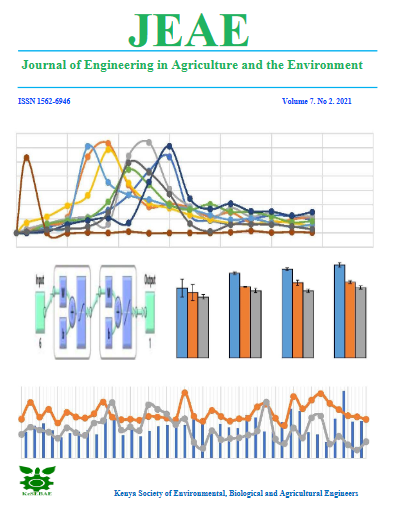Abstract
Storage and marketing of camel milk in arid lands of Kenya is hampered by lack of cold storage facilities. This problem can be alleviated by using storage structures incorporating evaporative cooling whose performance depends on climatic conditions. The objective of this work was to develop an artificial neural network (ANN) to predict cooled milk temperature and cooling efficiency of a locally fabricated cooler. Data were obtained from the cooler which was tested under various experimental conditions. Using some of the experimental data for training, a three-layer feed-forward ANN model based on back propagation Levenberg-Marquardt algorithm was developed using the Neural Network Toolbox for MATLAB®. The optimal model had a 4-4-2 structure with sigmoid transfer function in both layers. The inputs of the model were ambient dry bulb temperature, wet bulb temperature, wind speed and temperature of drip water, whereas the outputs were cooled milk temperature and cooling efficiency. The experimental data set (n=165) was randomly divided into training (75%) and testing (25%) sub-sets. The performance of the ANN predictions was evaluated by comparing the predicted and experimental results. The predictions agreed well with experimental values with mean squared error of 10.2, mean relative error of 4.02% and correlation coefficients in the range of 0.86-0.93. This study reveals that, as an alternative to conventional modelling techniques, the ANN approach can be used successfully for predicting the performance of locally fabricated camel milk storage structures incorporating evaporative cooling in arid pastoral areas of Kenya. The model can be used as a design tool to estimate the sizing and performance of future coolers, as it allows the prediction of the performance of hypothetical coolers designed without a need for time demanding experimentation. This can aid in up-scaling the technology.
References
Huang, Y., Kangas, L. J. and B. A. Rasco, 2007. Applications of artificial neural networks (ANNs)
in food science. Critical Reviews in Food Science and Nutrition 47(2):113-26.
Guiné, R. P., 2019. The use of Artificial Neural Network (ANN) in food process engineering. International Journal of Food Engineering 5(1): 15-21.
Moldes, O. A., Mejuto, J. C., Rial-Otero, R. and Simal-Gandara, J., 2017. A critical review on the
applications of artificial neural networks in wine making technology. Critical Reviews in Food
Science and Nutrition 57 (13): 2896-2908.
Wayua, F.O., Okoth, M.W. and J. Wangoh, 2012. Design and performance assessment of a low cost evaporative cooler for storage of camel milk in arid pastoral areas of Kenya. International Journal of Food Engineering, Volume 8, Issue 1, ISSN (Online) 1556-3758, DOI: 10.1515/1556-
2323, May 2012.
Hagan, M.T. and M. B. Menhaj, 1994. Training feed forward network with the Marquardt algorithm. IEEE Transactions on Neural Networks 5(6): 989 – 993.
Demuth, H., Beale, M. and M. Hagan, 2009. MATLAB User’s Guide: Neural Network Toolbox.
The MathWorks, Inc., MA, USA.
SPSS, 2011. IBM SPSS Statistics for Windows, Version 20.0., NY: IBM Corp.
Yousefi, G., Emam-Djomeh, Z., Omid, M. and G. R. Askari, 2014. Prediction of
physicochemical properties of raspberry dried by microwave-assisted fluidized bed dryer using Artificial Neural Network. Drying Technology 32: 4–12.

This work is licensed under a Creative Commons Attribution 4.0 International License.
